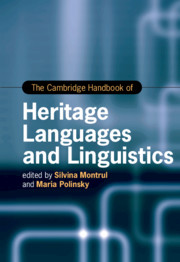Book contents
- The Cambridge Handbook of Heritage Languages and Linguistics
- Cambridge Handbooks In Language And Linguistics
- The Cambridge Handbook of Heritage Languages and Linguistics
- Copyright page
- Dedication
- Contents
- Figures and Tables
- Contributors
- Acknowledgments
- Introduction
- Part I Heritage Languages around the World
- Part II Research Approaches to Heritage Languages
- Part III Grammatical Aspects of Heritage Languages
- Part IV Heritage Language Education
- 29 Elementary School Heritage Language Educational Options and Outcomes
- 30 Community-Organized Heritage Language Programs
- 31 Curricular and Programmatic Language Development Opportunities for University-Level Heritage Language Learners
- 32 Instructed Heritage Language Acquisition
- 33 Issues and Practices in Community-Based Experiential Learning for Heritage Speakers in the United States
- 34 Developing Spanish Heritage Language Biliteracy
- 35 Heritage Language Assessment
- 36 Embracing Opportunity in Heritage Language Revitalization
- 37 Heritage Language Planning and Policy
- Index
- References
35 - Heritage Language Assessment
from Part IV - Heritage Language Education
Published online by Cambridge University Press: 04 November 2021
- The Cambridge Handbook of Heritage Languages and Linguistics
- Cambridge Handbooks In Language And Linguistics
- The Cambridge Handbook of Heritage Languages and Linguistics
- Copyright page
- Dedication
- Contents
- Figures and Tables
- Contributors
- Acknowledgments
- Introduction
- Part I Heritage Languages around the World
- Part II Research Approaches to Heritage Languages
- Part III Grammatical Aspects of Heritage Languages
- Part IV Heritage Language Education
- 29 Elementary School Heritage Language Educational Options and Outcomes
- 30 Community-Organized Heritage Language Programs
- 31 Curricular and Programmatic Language Development Opportunities for University-Level Heritage Language Learners
- 32 Instructed Heritage Language Acquisition
- 33 Issues and Practices in Community-Based Experiential Learning for Heritage Speakers in the United States
- 34 Developing Spanish Heritage Language Biliteracy
- 35 Heritage Language Assessment
- 36 Embracing Opportunity in Heritage Language Revitalization
- 37 Heritage Language Planning and Policy
- Index
- References
Summary
This chapter provides an overview of pedagogical heritage language (HL) assessment issues and an agenda for enhancing positive washback effects of assessment on HL learners in the future. After an introduction, the chapter first discusses the definition of HL learners used here and elsewhere. Second, it explores two distinct types of tests that are important and relevant to the subsequent discussions of HL assessment issues. The discussions reveal an apparent lack of validation studies for proficiency assessment tools in general and HL assessment in particular. For example, postsecondary placement investigations dealing with HL learners largely focus on Spanish but little is known for placement practices in other HLs. Also, the availability of assessment tools for pre-collegiate HL programs is very limited, especially for less commonly taught languages. Validation studies of existing assessment procedures for pre-collegiate HL programs are scarce. This chapter also points out that bilinguals’ dynamic and holistic use of linguistic repertoires adds complexity to assessing bilinguals’ HL proficiency. This chapter mainly discusses HL assessment in pedagogical contexts, but where relevant, it examines the use of HL tests for research as well.
Keywords
- Type
- Chapter
- Information
- The Cambridge Handbook of Heritage Languages and Linguistics , pp. 892 - 911Publisher: Cambridge University PressPrint publication year: 2021
References
- 2
- Cited by



